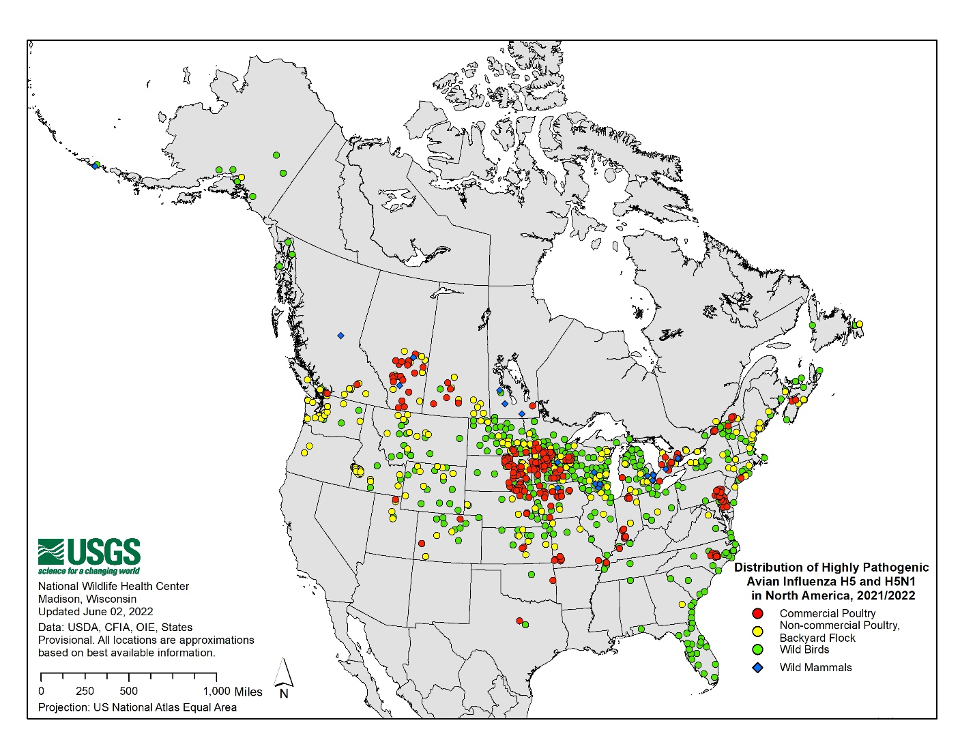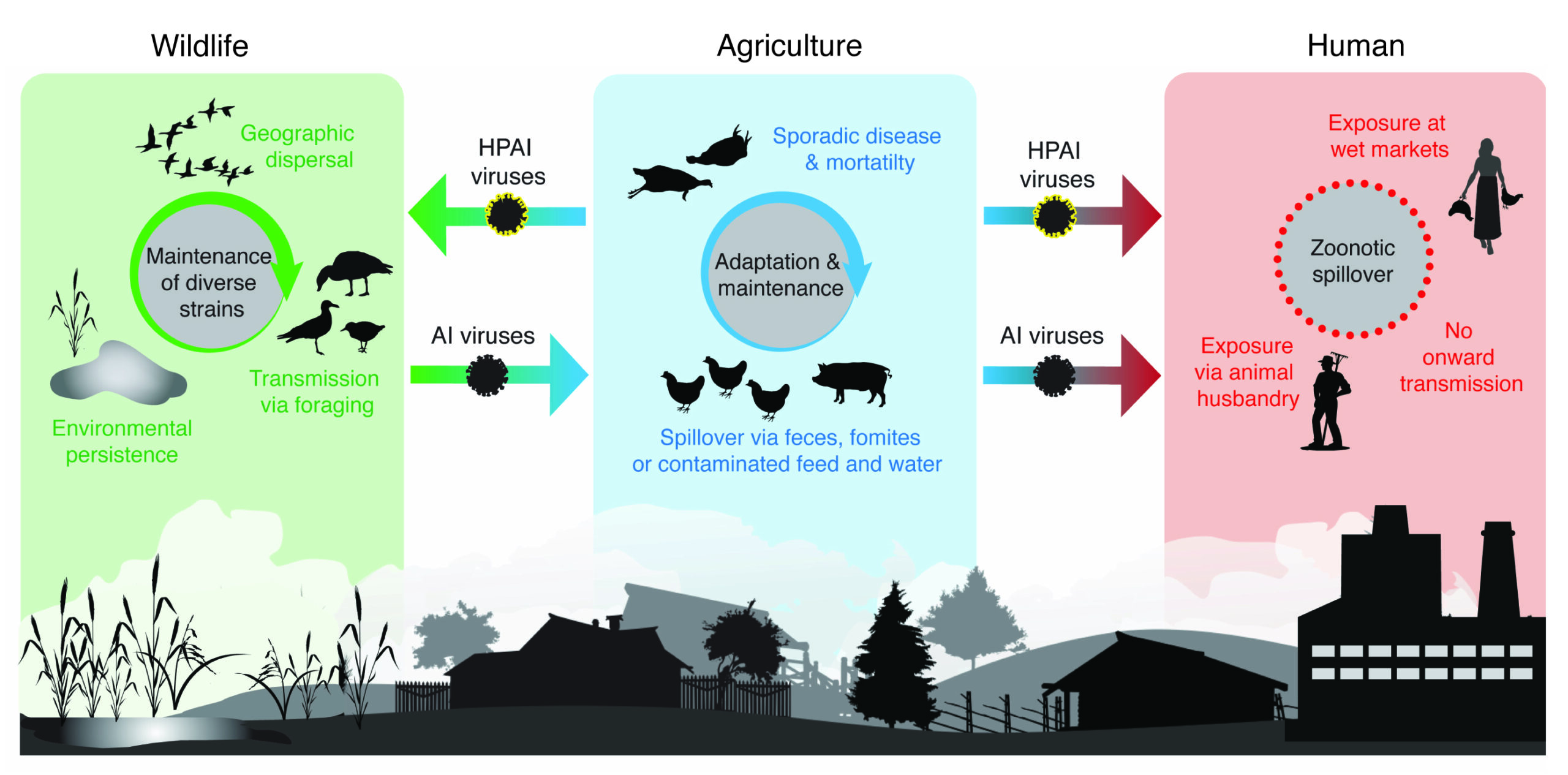By Andrew M. Ramey and Colleen M. Handel, U.S. Geological Survey
Linked paper: Highly pathogenic avian influenza is an emerging disease threat to wild birds in North America by A. M. Ramey, N. J. Hill, T. J. DeLiberto, S. E. J. Gibbs, M. C. Hopkins, A. S. Lang, R. L. Poulson, D. J. Prosser, J. M. Sleeman, D. E. Stallknecht, and X.-F. Wan. Journal of Wildlife Management.
Highly pathogenic avian influenza (HPAI) is an ecologically and economically significant avian disease that is quickly spreading among wild and domestic birds throughout North America. In this blog post, we provide information and resources that can help you to be informed, be prepared, and be ready to take appropriate action should you observe wild birds that may be affected by HPAI.
HPAI is a specific type of ‘bird flu’ that can cause serious disease and death in many species of birds. HPAI has long been recognized as an important poultry disease, but it only emerged as a significant source of mortality among wild birds over the past two decades. During this time, the global occurrence of HPAI in wild birds has increased substantially in Asia, Europe, Africa, and North America. In late December 2021, HPAI was detected in wild birds inhabiting North America for the first time since 2016. Detections in poultry followed soon thereafter. In just a few months, HPAI was detected in wild birds throughout much of the Atlantic Flyway as well as within the Mississippi, Central, and Pacific flyways. HPAI also quickly spread among domestic birds, with numerous detections occurring among commercial poultry facilities and non-commercial backyard flocks. As of 5 June 2022, there have been more than 1,700 confirmed detections of HPAI in wild birds this year in the U.S. and Canada as well as on more than 350 poultry premises, the latter having resulted in the death or destruction of approximately 38 million domestic birds. Even in the absence of disease, flocks of potentially exposed domestic birds have been euthanized in an attempt to control spread of the outbreak.

The current outbreak of HPAI in North America poses a serious threat to the health of wild birds and is particularly prevalent in waterfowl, other water-associated birds, and raptors. Signs of disease displayed by waterfowl and other species affected by HPAI include a lack of coordination, stumbling, inability to stand upright, inability to fly, swimming in circles, a twisted neck, and paralysis. It appears that waterfowl are contributing to the geographic spread of HPAI viruses among wild birds. Dabbling ducks such as Mallards (Anas platyrhynchos) and American Wigeon (Mareca americana) are commonly asymptomatic when infected by HPAI viruses and may be dispersing viruses through local and migratory movements.
While some wild birds may recover from HPAI infection, other birds succumb to disease and die. For example, raptors have consistently been reported to be adversely affected during the current outbreak of HPAI in North America. Reports of HPAI in eagles, hawks, and owls (Accipitriformes, Strigiformes) have been confirmed almost exclusively from sick or dead birds. When numerous birds die during a relatively short interval and at the same general location, this is typically referred to as a mortality event. Mortality events sometimes involve large numbers of birds. As part of the current outbreak in North America, there have been mortality events involving Lesser Scaup (Aythya affinis), Canada Geese (Branta canadensis), Ross’s Geese (Anser rossii), and Snow Geese (A. caerulescens). By comparison, confirmed reports among songbirds have been relatively rare to date and most prevalent among members of the family Corvidae (crows, ravens, jays, magpies). A few cases have also been confirmed among other primarily terrestrial bird species.
Important note: Thus far, there has been only a single case of a human infected by HPAI in the U.S. This case occurred in a person directly exposed to infected poultry as part of a culling effort. The affected person reported fatigue and has since recovered. The Centers for Disease Control (CDC) has determined that the ongoing HPAI outbreak in North America continues to pose low risk to human health but recommends protective actions around wild and domestic birds. The CDC has recently published an informative flyer regarding bird flu and human health.
If you work with wild birds or spend considerable time observing birds in North America or other areas where HPAI is currently circulating, we encourage you to be informed, be prepared, and take appropriate action should you observe birds that you suspect may be affected by HPAI.
So first, be informed. You are doing this now. Raising your situational awareness will help you make informed decisions pertaining to your observations, including whether or not to report them and how you should respond. Throughout this blog post are numerous links to websites where you can find additional information on HPAI. Please visit these websites and use information to develop a personalized response plan that you can follow should you observe sick or dead birds.
Next, be prepared. Developing a personalized response plan for yourself or your project may prove helpful should you encounter sick or dead birds in the field. Your plan should be developed in advance with critical thought and used to help you decide whether and how to respond to a disease or mortality event. Make sure to incorporate agency and organizational guidance into your personalized response plan. Perhaps your institution or organization already has a response that you can simply follow. Important considerations that your plan should address include: how to document your observations (pictures and video can be helpful!), how and to whom information should be communicated, and whether you have everything that you may need to work with or observe birds in a manner that protects your health as well as avian health (e.g., personal protective equipment [PPE] and disinfection materials/protocols).
Finally, once out in the field, if you come across sick or dead birds that you think may be affected with HPAI, take action as specified in your personalized response plan. Appropriate actions might be simply recording observations and reporting them to the local land manager. Observations recorded across space and time can help document the extent and trajectory of morbidity and mortality. If you are properly trained, have appropriate PPE, and have concurrence of the local land manager and the responsible diagnostic lab, you might collect carcasses for testing. If circumstances arise that you had not anticipated and you are unsure about how to proceed, consider that inaction might be preferable to taking the wrong action. The ongoing outbreak of HPAI in wild and domestic birds inhabiting North America represents a considerable challenge to the ornithological community in this region, comparable to, or in cases exceeding, HPAI situations faced recently by ornithologists in Europe, Asia, and Africa. Given the transboundary nature of HPAI, ornithologists in other regions such as the Caribbean, Central America, South America, Australia, and Oceania may face similar challenges in the future. Thus, wherever your ornithological work and observations may take place, we encourage you to use a wealth of publicly available information and online resources to be informed, be prepared, and be ready to take appropriate action to meet the challenges posed by HPAI and to actively participate in an informed global response.
